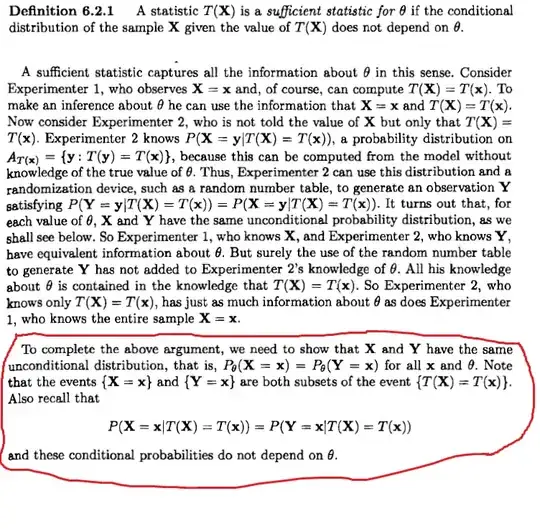It's just a matter of understanding the notation.
Preliminaries
A random variable, such as $\boldsymbol X$, is a measurable function on a probability space,
$$\boldsymbol X: \Omega \to \mathbb{R}^n.$$
A statistic $T$ is a measurable function
$$T: \mathbb{R}^n \to \mathbb{R}.$$
The composite function
$$T\circ \boldsymbol{X}:\Omega \to \mathbb{R};\ T(\boldsymbol{X})(\omega) = T(\boldsymbol{X}(\omega))$$
is therefore also a random variable.
Let $\boldsymbol{x}\in\mathbb{R}^n$: it is a possible value of $\boldsymbol X$. Therefore $t = T(\boldsymbol{x})\in \mathbb R$ is a possible value of the statistic $T$.
Notation
The set-building notation used in this context is a shorthand--some would say an abuse of--the more explicit mathematical notation
$$\{T(\boldsymbol X) = T(\boldsymbol x)\} = \{\omega\in\Omega\,|\,T(\boldsymbol{X}(\omega)) = T(\boldsymbol{x})\}= \{\omega\in\Omega\,|\,T(\boldsymbol{X}(\omega)) = t\}.$$
Let's call this set $\mathcal T$. The mathematical notation clearly exhibits $\mathcal T$ as a subset of $\Omega$ and, because $T\circ \boldsymbol X$ is measurable, it is an event. It is the set of all outcomes where the value of $T\circ\boldsymbol{X}$ equals a given value of the statistic $T$, namely $T(\boldsymbol{x}) = t$. In other words, $\mathcal T$ consists of all outcomes where the statistic $T$ has the value $t$.
Similarly, the other set-building notations used in the quotation should be interpreted as
$$\boldsymbol{X}^{*}(\boldsymbol{x}) = \{\boldsymbol{X} = \boldsymbol{x}\} = \{\omega\in\Omega\,|\,\boldsymbol{X}(\omega) = \boldsymbol{x}\}$$
$$\boldsymbol{Y}^{*}(\boldsymbol{x}) =\{\boldsymbol{Y} = \boldsymbol{x}\} = \{\omega\in\Omega\,|\,\boldsymbol{Y}(\omega) = \boldsymbol{x}\}.$$
Both of these are events: $\boldsymbol{X}^{*}(\boldsymbol{x})$ is the event where the value of $\boldsymbol X$ is $\boldsymbol x$ and $\boldsymbol{Y}^{*}(\boldsymbol{x})$ is the event where the value of $\boldsymbol Y$ is $\boldsymbol x$. They needn't be the same event, because $X$ and $Y$ are not necessarily the same random variable.
Solution
By construction, if we apply $T\circ \boldsymbol{X}$ to any element $\omega$ of either of these sets, we will obtain the value $T(\boldsymbol{x}) = t$, which by definition means $\omega\in\mathcal T$. We have merely observed that
$$\boldsymbol{X}(\omega) = \boldsymbol{x} \implies T(\boldsymbol{X}(\omega)) = t$$
and
$$\boldsymbol{Y}(\omega) = \boldsymbol{x} \implies T(\boldsymbol{Y}(\omega)) = t,$$
immediately proving that
$$\boldsymbol{X}^{*}(\boldsymbol{x}) \subset \mathcal T$$
and
$$\boldsymbol{Y}^{*}(\boldsymbol{x}) \subset \mathcal T,$$
QED.
